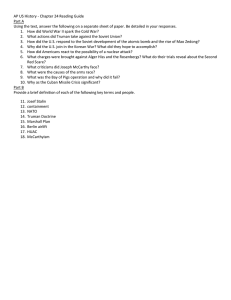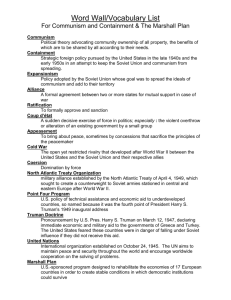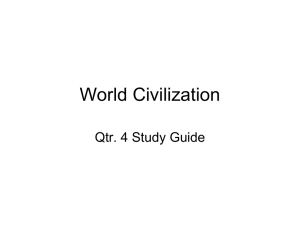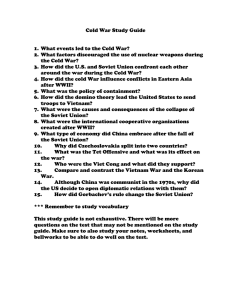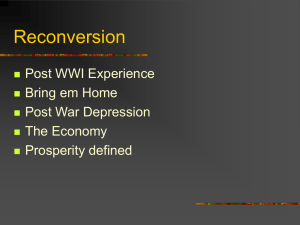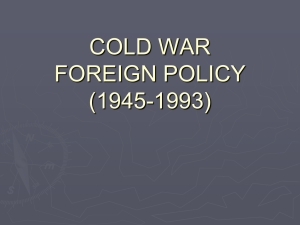COLD WAR -- FOREIGN POLICY - (1945-1993) Understanding the Cold War
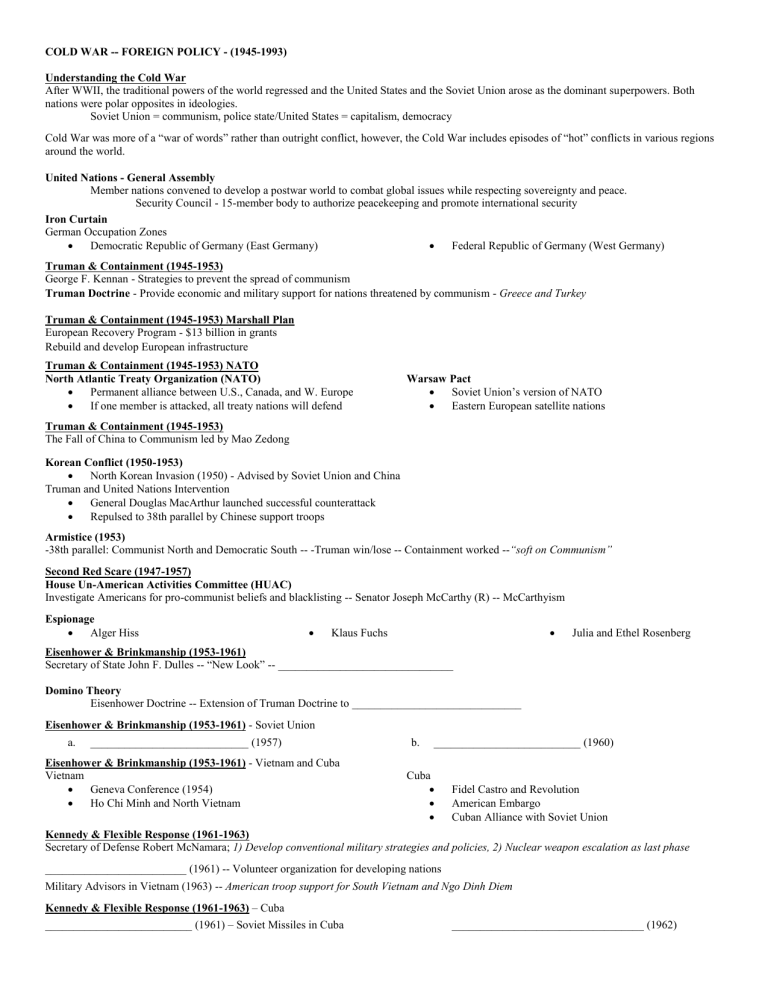
COLD WAR -- FOREIGN POLICY - (1945-1993)
Understanding the Cold War
After WWII, the traditional powers of the world regressed and the United States and the Soviet Union arose as the dominant superpowers. Both nations were polar opposites in ideologies.
Soviet Union = communism, police state/United States = capitalism, democracy
Cold War was more of a “war of words” rather than outright conflict, however, the Cold War includes episodes of “hot” conflicts in various regions around the world.
United Nations - General Assembly
Member nations convened to develop a postwar world to combat global issues while respecting sovereignty and peace.
Security Council - 15-member body to authorize peacekeeping and promote international security
Iron Curtain
German Occupation Zones
Democratic Republic of Germany (East Germany)
Truman & Containment (1945-1953)
George F. Kennan - Strategies to prevent the spread of communism
Federal Republic of Germany (West Germany)
Truman Doctrine - Provide economic and military support for nations threatened by communism - Greece and Turkey
Truman & Containment (1945-1953) Marshall Plan
European Recovery Program - $13 billion in grants
Rebuild and develop European infrastructure
Truman & Containment (1945-1953) NATO
North Atlantic Treaty Organization (NATO)
Permanent alliance between U.S., Canada, and W. Europe
If one member is attacked, all treaty nations will defend
Truman & Containment (1945-1953)
Warsaw Pact
Soviet Union’s version of NATO
Eastern European satellite nations
The Fall of China to Communism led by Mao Zedong
Korean Conflict (1950-1953)
North Korean Invasion (1950) - Advised by Soviet Union and China
Truman and United Nations Intervention
General Douglas MacArthur launched successful counterattack
Repulsed to 38th parallel by Chinese support troops
Armistice (1953)
-38th parallel: Communist North and Democratic South -- -Truman win/lose -- Containment worked --
“soft on Communism”
Second Red Scare (1947-1957)
House Un-American Activities Committee (HUAC)
Investigate Americans for pro-communist beliefs and blacklisting -- Senator Joseph McCarthy (R) -- McCarthyism
Espionage
Alger Hiss
Klaus Fuchs
Eisenhower & Brinkmanship (1953-1961)
Secretary of State John F. Dulles -- “New Look” -- _______________________________
Julia and Ethel Rosenberg
Domino Theory
Eisenhower Doctrine -- Extension of Truman Doctrine to ______________________________
Eisenhower & Brinkmanship (1953-1961) - Soviet Union b.
__________________________ (1960) a.
____________________________ (1957)
Eisenhower & Brinkmanship (1953-1961) - Vietnam and Cuba
Vietnam
Geneva Conference (1954)
Ho Chi Minh and North Vietnam
Cuba
Fidel Castro and Revolution
American Embargo
Cuban Alliance with Soviet Union
Kennedy & Flexible Response (1961-1963)
Secretary of Defense Robert McNamara; 1) Develop conventional military strategies and policies, 2) Nuclear weapon escalation as last phase
_________________________ (1961) -- Volunteer organization for developing nations
Military Advisors in Vietnam (1963) -- American troop support for South Vietnam and Ngo Dinh Diem
Kennedy & Flexible Response (1961-1963) – Cuba
__________________________ (1961) – Soviet Missiles in Cuba __________________________________ (1962)
Space Race
National Aeronautic and Space Administration (NASA) (1958) -- Response to Sputnik and Yuri Gagarin
Mercury Program
Alan Shepard - _______________________________ (1961) John Glenn - First American to orbit Earth (1962)
Kennedy’s Race to the Moon
Apollo Program - Apollo 11 (1969) - “One small step for man, one giant leap for mankind” - _______________________________
Johnson & Vietnam (1963-1969)
Gulf of Tonkin (August 1964) -- Incident - North Vietnamese fired upon U.S. warships
Resolution - Congress authorized combat troops through Johnson’s urging
Escalation
Troops increases from 1964 to 1969 Operation Rolling Thunder
Hawks and Doves
_____________________ - contain communist aggression
_____________________________ (January 1968)
Vietcong launch surprise attack
__________________ - internal conflict and unpopular draft and results
U.S. military victory but political and popular victory for Minh and North Vietnamese
Nixon & Detente (1969-1974)
Secretary of State ________________________________
Nixon Doctrine - Assist allies, but not assume all the world’s defense
Visit to China (1972)
Met with Chairman Mao
Soviet Union and Leonid Brezhnev
Visit to Moscow (1972)
Virtual recognition of Communist China Strategic Arms Limitation Treaty (SALT I) (1972)
Nixon & Detente (1969-1974) - __________________________________
Purpose
Expand, equip, and train South
Vietnamese
Reduce American troop involvement
Cambodia bombings – Protests back home – ____________________________
My Lai Massacre (1968) - U.S. troops slaughtered women and children
“Peace with honor”
Pentagon Papers (1971) - New York Times v. United States (1971)
War Powers Act (1973) – 1) 48 hours advance notice 2) 60 day military authorization, 30 day withdrawal
Paris Peace Accords (1973)
Fall of Viet Nam – Fall of Saigon
Carter & Human Rights (1977-1981)
1.
Camp David Accords (1978) a.
Peace between Egypt and Israel
2.
SALT II (1979)
4.
Iranian Revolution (1979) a.
b.
Ayatollah Khomeini
55 American hostages for 444 days
3.
Soviet Union and Afghanistan (1979) a.
Boycott of Moscow Olympics (1980) c.
Operation Eagle Claw (1980)
Reagan & Rollback (1981-1989)
Reagan Doctrine - Provide support for resistance movements against communist governments -- “peace through strength”
Iran-Contra Affair
Iran-Iraq War -- U.S. sold weapons to both sides; mostly to Saddam Hussein and Iraq
Nicaragua – 1) Sandinistas 2) Contras 3) Boland Amendment (1985)
Iran-Contra Affair - Weapons sales to Iran funded Contras against Sandinistas -- Colonel ______________________________
Reagan & Rollback (1981-1989) - Soviet Union and Gorbachev
“Evil Empire”
____________________________________ (SDI) - “Star Wars”
Brandenburg Gate - "Mr. Gorbachev, Tear Down This Wall."
Mikhail Gorbachev’s Reforms
_______________________ - Openness and freedom of expression
(Social)
End of Cold War (1989-1993) - Iron Curtain Falls
Germany - Berlin Wall falls (1989) and Reunification (1990)
Eastern Europe - Poland and Solidarity
Soviet Union - Dissolution (1991)
__________________________ -
(Economic)
Gradual capitalist reforms
